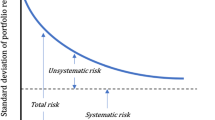Abstract
At the heart of optimal hedging with additive models in Yamada (Recent advances in financial engineering: proceedings of the KIER-TMU international workshop on financial engineering, World Scientific, pp 225–245, 2010; Proceedings of the 2011 American control conference, pp 3856–3861, 2011; Asia-Pac Financ Mark 19(2):149–179, 2012) is to replicate the payoff of European basket options using separate options as close as possible. In this paper, we extend their technique for the case of path-dependent barrier options, where the mean square error of the payoffs between the basket barrier option and the sum of options on the individual assets is minimized over any smooth payoff functions. To this end, we propose to represent the underlying assets using the Brownian bride decomposition and show that computations involving conditional expectations of basket barrier options boil down to those of unconditional expectations. This procedure enables us to provide an algorithm to compute the necessary and sufficient condition for the optimal hedging problem based on the Monte Carlo method. Then, we consider to apply our methodology to the Black–Cox type first passage time structural model, where a defaultable company possesses/runs multiple assets/projects and the default may occur the first time the asset value hits a certain lower threshold before the maturity. We formulate the equity value separation problem using additive models, in which individual equity values are introduced so that their sum approximates the total equity value as close as possible. It is also shown that any portion of total equity value may be assigned as an initial value of each individual equity when using the optimal smooth functions. Finally, we examine the contributions of individual equity values to default or survival by applying a certain normalization for conditional expectations via numerical experiments to illustrate our proposed methodology.


Similar content being viewed by others
References
Black, F., & Cox, J. C. (1976). Valuing corporate securities: Some effects of bond indenture provisions. Journal of Finance, 31, 351–367.
Black, F., & Scholes, M. (1973). The pricing of options and corporate liabilities. Journal of Political Economy, 81, 637–654.
Carr, P., Ellis, K., & Gupta, V. (1998). Static hedging of exotic options. Journal of Finance, 53(3), 1165–1190.
Carr, P., & Madan, D. (2001). Optimal positioning in derivative securities. Journal of Financial Econometrics, 1(3), 327–364.
Hastie, T., & Tibshirani, R. (1990). Generalized additive models. New York: Chapman & Hall.
Hobson, D., Laurence, P., & Wang, T. H. (2005). Static-arbitrage upper bounds for the prices of basket options. Quantitative Finance, 5(4), 329–342.
Merton, R. (1973). Theory of rational option pricing. Bell Journal of Economics and Management Science, 4, 141–184.
Merton, R. (1974). On the pricing of corporate debt: The risk structure of interest rates. Journal of Finance, 29, 449–470.
Primbs, J. A. (2009). Dynamic hedging of basket options under proportional transaction costs using receding horizon control. International Journal of Control, 82(10), 1841–1855.
Shreve, S. E. (2004). Stochastic calculus for finance II: Continuous-time models. Berlin: Springer.
Su, X. (2008). Essays on basket options hedging and irreversible investment valuation. Ph.D. Dissertation, University of Bonn.
Yamada, Y. (2010). Optimal hedging with additive models. In Recent advances in financial engineering: Proceedings of the KIER-TMU international workshop on financial engineering (pp. 225–245). World Scientific.
Yamada, Y. (2011). Optimal hedging for multivariate derivatives based on additive models. In Proceedings of the 2011 American control conference (pp. 3856–3861).
Yamada, Y. (2012). Properties of optimal smooth functions in additive models for hedging multivariate derivatives. Asia-Pacific Financial Markets, 19(2), 149–179.
Author information
Authors and Affiliations
Corresponding author
Additional information
This work is supported by Grant-in-Aid for Scientific Research (A) 16H01833 from Japan Society for the Promotion of Science (JSPS).
Rights and permissions
About this article
Cite this article
Yamada, Y. Optimal Hedging of Basket Barrier Options with Additive Models and Its Application to Equity Value Separation Problem. Asia-Pac Financ Markets 24, 1–18 (2017). https://doi.org/10.1007/s10690-016-9221-y
Published:
Issue Date:
DOI: https://doi.org/10.1007/s10690-016-9221-y



